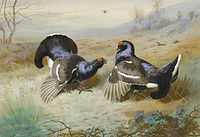
Photo from wikipedia
Aggression is often measured in the laboratory as an iterative "tit-for-tat" sequence, in which two aggressors repeatedly inflict retaliatory harm upon each other. Aggression researchers typically quantify aggression by aggregating… Click to show full abstract
Aggression is often measured in the laboratory as an iterative "tit-for-tat" sequence, in which two aggressors repeatedly inflict retaliatory harm upon each other. Aggression researchers typically quantify aggression by aggregating across participants' aggressive behavior on such iterative encounters. However, this "aggregate approach" cannot capture trajectories of aggression across the iterative encounters and needlessly eliminates rich information in the form of within-participant variability. As an alternative approach, I used multilevel modeling (MLM) to examine the slope of aggression across the 25-trial Taylor Aggression Paradigm as a function of trait physical aggression and experimental provocation. Across two preregistered studies (combined N = 392), participants exhibited a modest decline in aggression. This decline reflected a reciprocal strategy, in which participants responded to an initially-provocative opponent with greater aggression that then decreased over time to match their opponent's declining levels of aggression. Against predictions, trait physical aggression and experimental provocation did not affect participants' overall trajectories of aggression. Yet, exploratory analyses suggested that the participants' tendency to reciprocate their opponent's aggression with more aggression was greater at higher levels of trait physical aggression and attenuated among participants who had already been experimentally provoked by their opponent. These findings (a) illustrate several advantages of an MLM approach as compared with an aggregate approach to iterative laboratory aggression paradigms; (b) demonstrate that the magnifying effects of trait aggression and experimental provocation on laboratory aggression are stable over brief time-frames; and (c) suggest that modeling the opponent's behavior on such tasks reveals important information.
Journal Title: Aggressive behavior
Year Published: 2019
Link to full text (if available)
Share on Social Media: Sign Up to like & get
recommendations!